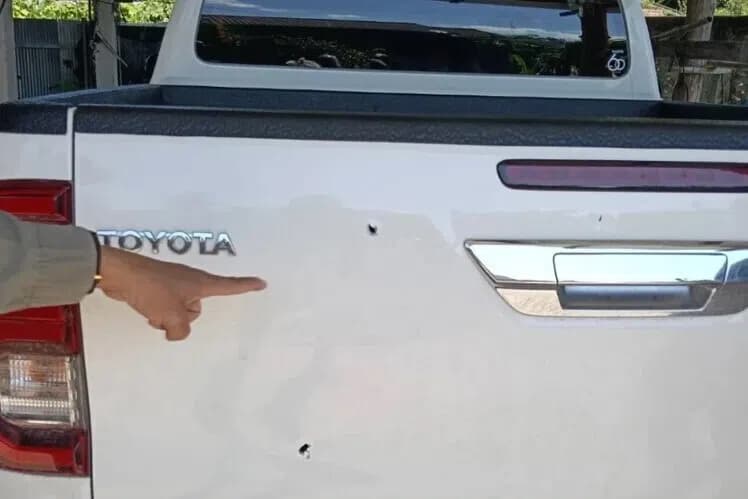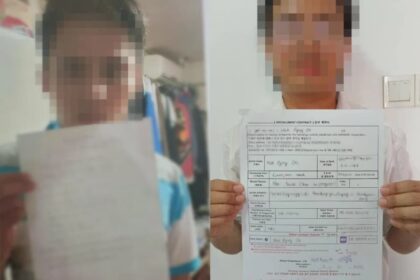Clashes on the frontier escalate overnight
Late on Friday, November 21, heavy fighting near Myawaddy in Myanmar spilled across the border into Thailand, when a single mortar or heavy shell landed in Ban Mae Kon Ken village in Mae Sot district, Tak province. The round struck a vegetable plot on the Thai side around 11 pm, damaging property but causing no injuries, according to Thai military briefings and local officials.
- Clashes on the frontier escalate overnight
- Where the fighting is and why it matters
- Thai rules of engagement and the warning shot
- Damage in Ban Mae Kon Ken and the human toll
- Spillover risks and recent incidents along the border
- The wider war in Myanmar and the battle for trade routes
- Thailand’s balancing act, security first with an eye on commerce
- What to watch in the days ahead
- Key Points
Thai units reported that the projectile fell at house number 41 in Village 4, property of Ms Thongkham Nuana ai, with shrapnel tearing into a nearby vehicle and parts of the home. Nearby houses also suffered broken windows and minor structural damage. Residents described a loud blast followed by falling debris and brief power cuts, as security forces moved in to cordon the area.
Within minutes, the Rachamanu Task Force, under the Naresuan Force, answered with a single warning shot at 11.05 pm. The Thai Army said the round, fired from a 120 mm mortar and loaded with smoke, was aimed at an open area on the Myanmar side between the opposing forces. The aim was to signal both sides to keep their fire inside Myanmar and to deter any further overshoot into Thai territory. Border command also reached out through the Thai Myanmar Border Committee, urging military counterparts to prevent any projectiles from entering Thailand.
Thai commanders reinforced positions opposite the combat zone and placed troops on heightened alert along the frontier near Mae Sot. Officials reported that about 125 people from Myanmar crossed into Thailand to escape the clashes. Humanitarian teams distributed food, water, and temporary shelter while Thai authorities monitored the battle across the river with drones and ground observers.
Where the fighting is and why it matters
Myawaddy township sits across the Moei River from Mae Sot, one of Thailand’s busiest gateways for trade with Myanmar. The highway linking the two towns is part of the Asia Highway network that carries goods between Thai factories and Myanmar markets and ports. Control of this corridor brings revenue, supplies, and a strategic river crossing. That makes Myawaddy a frequent flashpoint in the wider Myanmar war.
Who is involved around Myawaddy
On the Myanmar side, the military is battling a mix of ethnic armed groups and local resistance units that oppose the junta. Units from the Myanmar Army’s 22nd light infantry division have fought to push resistance fighters out of wooded terrain near Nila Paan village in recent days. Resistance commanders have relied on guerrilla tactics, including sniper fire, to conserve ammunition while trying to slow government advances. Both sides have used mortars and machine guns, and the sounds of explosions have echoed across the river into Mae Sot.
Why Mae Sot matters to Thailand
Mae Sot is a trade and logistics hub for western Thailand. Thousands of trucks normally pass through the border gate in calmer periods, carrying consumer goods, fuel, building materials, and farm produce. When the Myanmar side erupts, crossings slow or stop and Thai border communities absorb the impact. Shops close early, schools review safety plans, and local workers fear for relatives across the river. Thai authorities use long established communication channels with their counterparts to tamp down risks and keep trade moving when possible.
Thai rules of engagement and the warning shot
Thai forces operate under strict rules when fighting spills toward their territory. The priority is to protect lives and property on Thai soil while avoiding escalation. Commanders have authority to fire a warning round if rounds cross the border, but they avoid direct engagement unless Thai troops or civilians face an imminent threat. In Friday’s incident, leaders chose a smoke round to send a clear message without adding fragmentation to a chaotic battlefield.
A 120 mm mortar is a heavy weapon that can fire high explosive shells many kilometers. When loaded with smoke, it produces a visual cue and obscuring cloud rather than a blast effect. Firing into an open area between opposing forces creates a marked boundary and a caution to commanders on the Myanmar side. The response also signals that Thai units are present in strength and are prepared to act if violations continue.
Thai border protection units say they are monitoring the line constantly. Patrols, early warning posts, and cameras help spot errant fire quickly. Liaison officers use established hotlines and border committees to deliver immediate protests and to coordinate deconfliction. Provincial officials, including the governor of Tak, inspected the area after the blast and met residents to hear concerns and explain safety measures.
Damage in Ban Mae Kon Ken and the human toll
Residents of Ban Mae Kon Ken woke to shattered glass and scarred walls. Windows broke under the pressure wave and pieces of metal pierced roofs and fences. One pickup truck parked near the blast site took several fragments. Thai authorities said no one was hurt, a result of the late hour and the location of the strike in a garden plot on the edge of the village.
Local officials counted damage to several homes. One of the properties is registered to Ms Thongkham Nuana ai. In nearby lanes, families swept debris at dawn while electricians reconnected lines. Soldiers photographed crater marks and collected fragments to help identify the type of round. Residents said the shell felt like a mortar, and some military assessments pointed to a 60 mm caliber, a common light mortar used by infantry units.
Across the river on the Myanmar side, the fight drives civilians to flee. Thai authorities said at least 125 people crossed into Mae Sot for safety. Temporary shelters on the Thai side now provide mattresses, food, drinking water, and medical checks. Officials are working with local charities to support families separated by the fighting. Many arrivals hope to return quickly if the guns fall silent, but they face uncertainty as engagements ebb and surge near the river.
Thailand traditionally keeps its border open for short term protection during intense clashes. Rights groups have urged the government to avoid forced returns to danger zones and to set clearer protection standards for new arrivals. The laws of armed conflict and long practice in humanitarian response point to a simple principle, civilians should be kept safe and never punished for seeking refuge.
Spillover risks and recent incidents along the border
The Mae Sot area is not the only stretch of the frontier that has seen stray rounds this year. In March, residents in Mae Hong Son province reported a mortar shell landing on a cabbage farm near Ban Na Pa Paek, amid fighting between the Myanmar Army and the Karenni Army. Thai authorities heightened security and told villagers to use caution when traveling near hills and river crossings while the clashes continued. No injuries were reported in that incident, but it reinforced a lesson for communities along the frontier, heavy weapons used near the border can put Thai farms and homes at risk even when they are not the intended targets.
Mortars are indirect fire weapons. Crews arc rounds over distance using sighting tools and maps, but accuracy depends on terrain, training, and weather. At longer ranges, rounds can fall short or overshoot. When battles happen close to international lines, the margin for error can carry rounds into neighboring countries. That is why Thai commanders repeatedly press counterparts to shift firing positions farther from the river and to avoid using heavy weapons near populated areas.
The wider war in Myanmar and the battle for trade routes
Almost five years after Myanmar’s 2021 coup, fighting continues across the country. Ethnic armed groups and local resistance forces hold ground in many border regions. The military controls main cities and major highways in central areas, but it struggles to extend control deep into territories where local fighters have roots and community support. Lines of control have hardened in many places, and the war has turned into a grind for territory and supply routes.
Trade corridors that link Myanmar to its neighbors are under constant pressure. In the north, towns along the Mandalay to Muse highway have changed hands. In the west, the Arakan Army has taken control of large parts of Rakhine State while a junta garrison at Kyaukphyu remains under siege. In the east, Myawaddy is the key to a direct link with Thailand. Control of that gate affects customs revenue, troop logistics, and the flow of goods into resistance strongholds. Any flare up near this crossing has knock on effects for markets in both countries.
Regional powers shape the conflict through diplomacy and supply. China has pressed armed groups on its border to avoid moves that threaten trade and has dealt with both junta and non state actors to keep rare earth exports flowing. Russia supplies aircraft and technical support to the military. Western influence is limited, and regional states often focus on stability first. Against this backdrop, Thailand has stuck to a pragmatic approach, keeping channels open with all sides while protecting its communities and trade.
Thailand’s balancing act, security first with an eye on commerce
Bangkok’s posture on the frontier blends vigilance with restraint. Border units are heavily deployed along river crossings and mountain trails. The army uses warning shots and protests to set red lines, and it avoids being drawn into battles on foreign soil. Civilian agencies work in tandem with soldiers to support temporary shelters, regulate crossings, and keep roads safe. When violence spikes next to the bridge at Mae Sot, provincial officials coordinate detours and opening hours to manage risk without shutting down the gateway entirely.
In this latest incident, the single smoke round carries several messages. It warns combatants that Thailand will not tolerate spills of fire into its villages. It shows local residents that soldiers are close by and responsive. It also leaves room for de escalation. By avoiding high explosive munitions and by firing into an open patch between rival forces, Thai commanders asserted sovereignty and lowered the chance of casualties on the Myanmar side.
Thai officials have also moved to strengthen communication with their counterparts across the river. Staff officers used the Thai Myanmar Border Committee to urge tighter fire control. Provincial leaders visited the village, checked on repairs, and encouraged residents to report any new blasts or debris. The army says its border protection units will maintain a round the clock watch, with patrols ready to move if there is any further threat to Thai citizens.
What to watch in the days ahead
The pattern along this stretch of the frontier is familiar. Fighting in Myawaddy surges, rounds land near the river, and civilians seek temporary refuge in Mae Sot. Thai reinforcements flow to forward posts, and liaison officers push for restraint. If gunfire and shelling subside in coming days, border trade and daily life on the Thai side will return to a measured rhythm. If clashes intensify, Thai units are likely to increase patrols, reinforce positions opposite the hot spots, and use additional warning measures if needed.
Residents on the Thai side can expect more visible army presence, road checkpoints near river crossings, and periodic safety advisories. Schools and local officials may adjust schedules if the fighting gets closer to the river. Authorities have urged people in exposed hamlets to stay indoors at night, report any fragments or suspicious objects to police or soldiers, and avoid riverside fields when gunfire is audible. Humanitarian agencies stand ready to expand support if more families cross from Myanmar.
Key Points
- A single mortar or heavy shell from fighting in Myanmar landed in Ban Mae Kon Ken, Mae Sot district, late on November 21, damaging homes but causing no injuries.
- Thai forces fired one 120 mm smoke warning round at 11.05 pm into an open area on the Myanmar side to signal combatants to keep fire away from Thailand.
- At least 125 people from Myanmar crossed into Mae Sot to escape the fighting, and Thai authorities provided food, water, and temporary shelter.
- Thai units reinforced positions along the frontier opposite Myawaddy and used border committees to press counterparts for tighter fire control.
- Myawaddy is a key trade crossing, so clashes near the river can disrupt commerce and daily life in Mae Sot.
- Earlier this year, another shell landed in Mae Hong Son province during clashes, underscoring the risk of stray rounds along the long border.
- Thailand aims to protect sovereignty and civilians while avoiding escalation, using warning rounds, surveillance, and direct communication.












